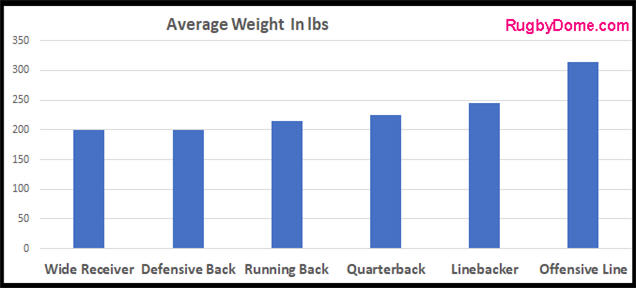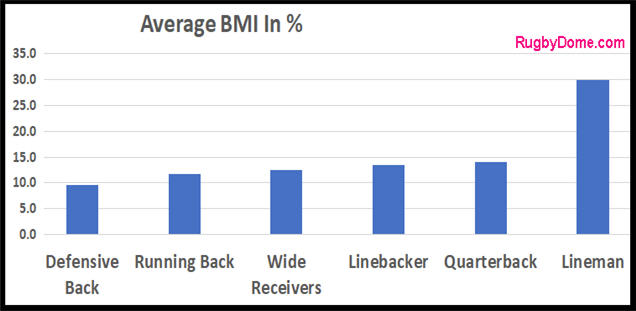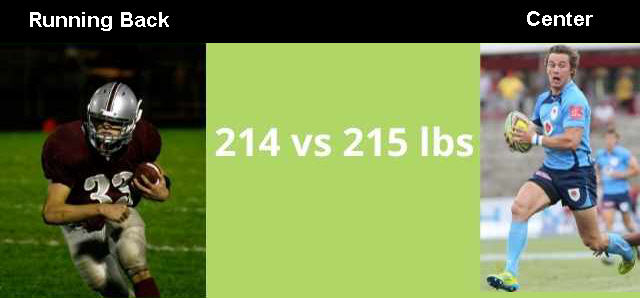The average weight of running backs in the NFL is 214 lbs in recent years. This is one of the lightest positions in football but is heavier than the average wide receiver.
Running backs in college football have an average weight of 202 lbs.
Why Are Running Backs Lighter Than Many Other Positions?
Running backs average about one hundred pounds lighter than offensive linemen, who are the heaviest players on the field.
That difference is the size of a baby hippo!
They are also lighter than quarterbacks and linebackers, although are about 14 lbs heavier than wide receivers. This graph shows how they stack up.

Why are running backs so light compared to other positions? The reason is due to their role on the field.
Like wide receivers, running backs often have to run wide to catch long passes. But one of their primary roles is to take a handoff and race with the ball as far up the field as they can.
With such an emphasis on speed, running backs have to be relatively light.
Average weight per position
Here is the raw data:
| NFL | lbs |
| Offensive Line | 314 |
| Linebacker | 245 |
| Quarterback | 225 |
| Running Back | 214 |
| Wide Receiver | 200 |
| Defensive Back | 200 |
If you want more details, check out these in-depth articles:
- Average lineman weights in NFL and college football
- Average linebacker weights in NFL and college football
- Average quarterback weights in NFL and college football
- Average wide receiver weights in NFL and college football
- Average defensive back weights in NFL and college football
How Do NFL Running Backs Compare To College Football?
College football players aren’t as heavy as professional NFL players, but they can still be pretty big.
The average weight of running backs in college football is 202 lbs, which is about twelve pounds lighter when compared to the NFL.
That means college running backs don’t have to pile on as much weight as other positions in their rookie season in the NFL.
For example, Greg Ruegamer was a talented lineman at Arizona State who weighed 290 lbs in his senior year. The Miami Dolphins coach got on the phone to him on NFL draft day and asked him to add another 30 lbs to his bulk.
Running backs aren’t under the same kind of pressure when transitioning from college football.
How Do Running Backs Compare To The Average American Male?
The average American man weighs 196 lbs according to the CDC. That’s a significant eighteen pounds less than the average NFL running back.
But what about body fat percentage?
A study in 2013 found that running backs have an average body fat percentage of 11.8%.
The average male in the United States has a percentage of about 28%, which makes running backs considerably leaner.
That may not surprise you. But how does this compare to the heaviest position in the NFL? Linemen clock in at nearly 30% body fat percentage.
Here is how the average running back stacks up across the different positions:

History Of Average Weights Of Running Backs In The NFL
It’s difficult to compare weights through history as positions and roles have changed significantly.
But we’ll take a look at some of the greats of past decades.
The famed Jim Brown weighed about 230 lbs when he starred for the Cleveland Browns in the early 1960s.
Jumping to the 1970s, Walter Payton of the Chicago Bears weighed about 200 lbs. But Payton was an outlier for being so light in these times.
Marshall Faulks of the Colts and Rams weighed about 211 lbs through the 1990s. Emmitt Smith of the Cowboys weighed about 216 lbs through the same period.
It’s a small sample! However, older NFL fans can use their eyes and memories to judge that running backs are lighter now than they used to be.
How Do Running Backs Compare To Other Sports?
Let’s take a look at heavyweights in boxing. Anthony Joshua weighs about 240 lbs, which is considerably heavier than the average running back.
But backs are 44 lb heavier than the 170 lb average weight of soccer players recorded at the 2018 World Cup.
But it doesn’t make a whole lot of sense to compare NFL with soccer players. We should look at another contact sport.
Rugby is probably the closest sport to American football.
Actually, didn’t they used to be the same? No, not really. If you’re interested in football history, check out our article on whether American football came from rugby.
Running backs versus rugby centers
Of course, the positions and roles don’t line up easily when comparing the two games.
But we figure that centers in rugby are the closest position to running backs in football.
We’ve got a full article comparing the size of NFL players to rugby players across multiple positions.
I’ll summarize here by saying that rugby centers and football running backs weigh almost exactly the same.

Our detailed analysis has the football players about one pound lighter than their rugby equivalent.